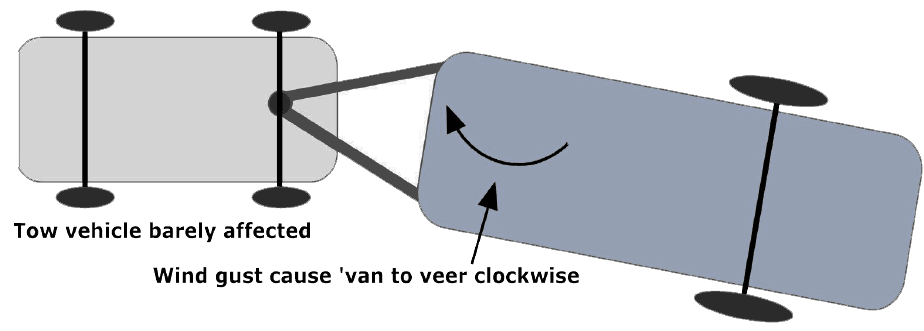Why Caravans Roll Over – Sample Chapter
CHAPTER ONE
Why and how travel trailers sway
There are two main types of vehicle-drawn trailers: dog-trailers and pig-trailers: (why such trailers are so-called is unknown).
Dog-trailers
Dog-trailers have two or more axles. One axle (at the front) pivots, or has so-called Ackerman steered wheels (as used at the front of cars and trucks). Either way enables the trailer to be steered by the vehicle’s drawbar.
Such trailers have long since proved stable. Many load-carrying commercial versions are used to this day – but the dog trailer configuration (Figure 1.1) is now rarely used in travel trailer form.

Figure 1.1. Dog trailer. Pic: www.l2sfbc.com
In practice, dog trailers shimmy slightly on rough roads but are not prone to ‘wagging the tail’ of whatever tows them.
Pig-trailers
Pig-trailers (Figure 1.2) have single or double (and sometimes triple) axles. These are ideally positioned and laden such that the trailer is about 10% nose heavy. Chapter Four explains why.

Figure 1.2. Pig trailer. Pic: www.l2sfbc.com.
Pig trailers are coupled to the tow vehicle via a hitch at the rear of that vehicle – well behind the centre-line of the tow-vehicle’s rear axle.
In their original (late 1890s) commercial load-carrying form, pig trailers rarely exceeded walking speed and stability was not a problem. By 1920, however, vehicle speeds had increased and such rigs increasingly jackknifed and overturned. Even back then, the pig trailer concept was proving fundamentally unstable.
Hitch overhang
Around 1921, US trailer maker Fruehauf realised that if the trailer yawed in one direction, that overhang hitch not just allowed, but caused, the tow vehicle to yaw in the other direction.
If the tow vehicle or the pig-trailer yaws (sways) each, via that overhung hitch, exerts side forces on the other – but in the opposite direction. Friction and other damping reduces yaw but only effective at low to medium speeds. By 100 km/h it has negligible effect (see Chapter Four).
Fruehauf further established that the shorter the hitch overhang and the longer the tow-vehicle’s wheelbase (distance between its front and rear wheels) the better. The company also found, and it later became clear why, that the laden tow vehicle needed to be at least as heavy as the laden trailer, and that the greater that ratio, the better.
Eliminating hitch overhang
Having established the major cause of instability was hitch overhang, Fruehauf took that finding to the extreme: that locating the tow-hitch directly over the tow-vehicle’s rear axle/s eliminated that instability. So why have any at all? Fruehauf’s solution firmly established the fifth-wheel concept. It had been used, in 1917, in a one-0ff fifth-wheel travel trailer designed by Glen Curtiss, but did not become popular (mainly in the USA) until the early 1930s.

Figure 1.3. Pig trailer yawing. Pic: rvbooks.com.au
Fifth-wheeler – zero yaw
If the tow hitch is directly over the tow-vehicle’s rear axle neither tow vehicle nor trailer yaw will affect the other (Figure 1.4).
Like the pendulum of an old-fashioned grandfather clock, that trailer is free to move. Wind gusts may cause the trailer to yaw slightly, but that yaw has no effect on the tow vehicle – or vice versa. Driving a fifth-wheel travel trailer rig feels much like driving a motorhome.
Whilst conventional travel trailer stability issues are primarily caused by tow hitch overhang, many other aspects are involved. Almost all, however, are associated with, and ultimately determined by hand-sized patches of rubber: i.e. the tow vehicle’s and (but less so) the travel trailer’s tyre contact patches that grip the road.
How contact patches do that profoundly affects every aspect of how tyred road vehicles behave. This is covered in the following Chapter.
How tyres profoundly control (stabilising) understeer, and (unstabilising) oversteer, is covered in Chapter Three.

